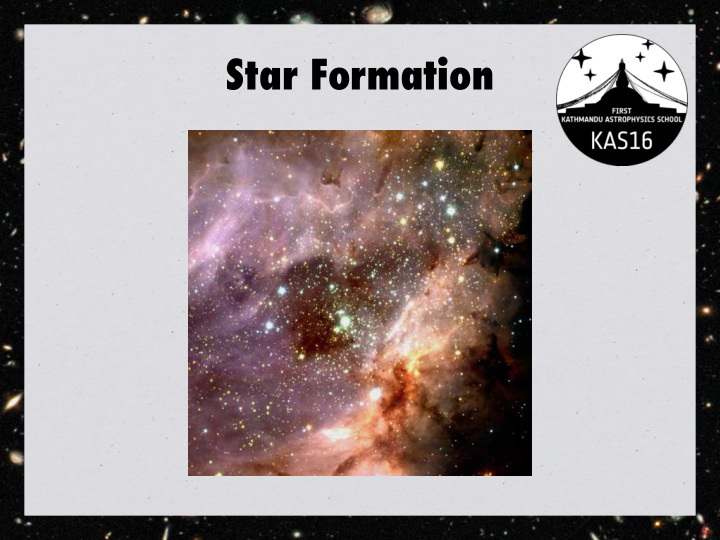



Star Formation
Dark Matter and Baryons ★ Gravity (DM) defines large scale structure of the Universe ★ Baryons are mostly hitchhiking a ride ★ Yet, their physical interactions are far richer ★ “Gastrophysics” ★ How are stars formed? KAS16/MT Lecture1II - Star Formation 2
KAS16/MT Lecture1II - Star Formation 3
KAS16/MT Lecture1II - Star Formation 4
KAS16/MT Lecture1II - Star Formation 5
KAS16/MT Lecture1II - Star Formation 6
KAS16/MT Lecture1II - Star Formation 7
KAS16/MT Lecture1II - Star Formation 8
KAS16/MT Lecture1II - Star Formation 9
KAS16/MT Lecture1II - Star Formation 10
KAS16/MT Lecture1II - Star Formation 11
KAS16/MT Lecture1II - Star Formation 12
KAS16/MT Lecture1II - Star Formation 13
KAS16/MT Lecture1II - Star Formation 14
KAS16/MT Lecture1II - Star Formation 15
KAS16/MT Lecture1II - Star Formation 16
KAS16/MT Lecture1II - Star Formation 17
★ Gas in the Interstellar Medium is not dense enough KAS16/MT Lecture1II - Star Formation 18
Radiative cooling ★ How do you expect cooling to depend on metallicity of gas? KAS16/MT Lecture1II - Star Formation 19
Radiative cooling and “metals” ★ The more “metals” the more efficient the cooling: many energy levels available ★ Simple atoms and molecules are inefficient at radiative cooling ★ Metal-free gas (Z<10 -3.5 Z Sun ) hard to cool ★ What is your expectation for the Jeans mass in first gas clouds? KAS16/MT Lecture1II - Star Formation 20
Log{Cooling efficiency} ★ But cooling efficiency grows with temperature KAS16/MT Lecture1II - Star Formation 21
Log{Cooling efficiency} ★ But cooling efficiency grows with temperature ★ WHY? KAS16/MT Lecture1II - Star Formation 22
DM halos and cooling of gas ★ Temperature of gas in DM halos depends on halo mass and redshift ★ There is a minimum halo mass for which cooling is efficient (cooling time less than Hubble time) KAS16/MT Lecture1II - Star Formation 23
Minimum halo for cooling T vir =1e4K M cool minimum halo mass for cooling z Trenti & Stiavelli (2009) KAS16/MT Lecture1II - Star Formation 24
The simple picture Gas cloud starts to contract It gets smaller and denser And smaller... Denser, Hotter until H-fusion begins: A star is born! KAS16/MT Lecture1II - Star Formation 25
KAS16/MT Lecture1II - Star Formation 26
KAS16/MT Lecture1II - Star Formation 27
KAS16/MT Lecture1II - Star Formation 28
KAS16/MT Lecture1II - Star Formation 29
T [K] n [cm -3 ] Smith et al. (2009) KAS16/MT Lecture1II - Star Formation 30
KAS16/MT Lecture1II - Star Formation 31
KAS16/MT Lecture1II - Star Formation 32
KAS16/MT Lecture1II - Star Formation 33
Recommend
More recommend